
Kent Anderson Butler's Ten-Year Survey at Kellogg Gallery, Cal Poly / Pomona, CA. | Courtesy of the Artist.
There is a storefront space that is being used temporarily as an art gallery by California Baptist University (CBU) that is situated on downtown Riverside's pedestrian mall. Amid the literature about their various arts programs there is a bold expression of the university's Christian faith: "In keeping with CBU's mission to help students discover and live their God-given purpose, the Film Studies program...."
It is a statement that strikes me in this December month, when it's the lead up to Christmas and the celebration of Christ's birth. I'm fascinated with living artists who bring their faith into their art because it is perhaps anathema to the 20th and 21st centuries of modernism and postmodernism that have been very much about questioning all forms of authority, whether it be politics, education, history, art, or religion. In essence, it seems to me, that it is near impossible to express one's faith openly in art, at least within the upper echelons of the contemporary world that is formed by the triumvirate of art school, gallery, and museum.
Other evangelical, Christian colleges in the geographic vicinity, down the 60-West from Riverside, share CBU's sentiments, such as Biola University in La Mirada and Azusa-Pacific University in Azusa, who have strong art programs too. Biola purports itself "as an acknowledged leader in Christian visual arts education," and Azusa-Pacific's aim is "to prepare art students for a lifetime of artistic expression and to cultivate individual creativity through the study of history, technique, presentation, and social engagement, as a reflector of the creative and transformative nature of God."
Nationally, there are organizations such as Christians in the Visual Arts that document some of the better faith-based work. There are ecumenically minded museums too, such as Saint Louis University's Museum of Contemporary Religious Art (MOCRA), the world's first interfaith museum of contemporary art that engages religious and spiritual themes.
In the not too distant past, artists could pretty much only portray religious and historical subject matter, along with landscape and portraits of the ruling class. It was not until the invention of photography, which freed painters from the servitude of portraiture, and the rise of the middle-class, which was a little more secular minded with its new found access to power via their entrepreneurship, that artists began to experiment with technique and subject matter, such as with the French Impressionists in the late-1800s.
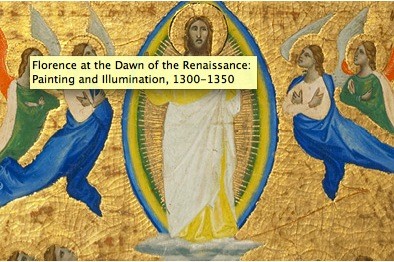
The Ascension of Christ (detail) from the Laudario of Sant'Agnese, about 1340, Pacino di Bonaguida. Tempera and gold on parchment, 17 1/2 x 12 1/2 in. (44.4 x 31.8 cm). The J. Paul Getty Museum, Ms. 80a, verso | Source: http://www.getty.edu/art/exhibitions/florence/index.html
Two current SoCal exhibitions act as kind of bookends to European Christian Art. The Getty's Florence at the Dawn of the Renaissance: Painting and Illumination, 1300-1350, depicts an early Mannerism that is less realist and more stylistic in its depiction of Jesus and his disciples. LACMA's Bodies and Shadows: Caravaggio and His Legacy, outlines one artist's introduction of naturalism and drama to the topic, making Biblical sagas and legends alive again, which refueled Catholicism reign over religious image making. Today, it is rare for the Catholic Church to support this level of artistic patronage, at least in the traditional fine arts. In Protestantism, one may find it more in their support of architects to develop aspiring architecture, since the interior is largely void of images, due to the history of the Protestant Reformation's attack on Catholicism's idolatry.
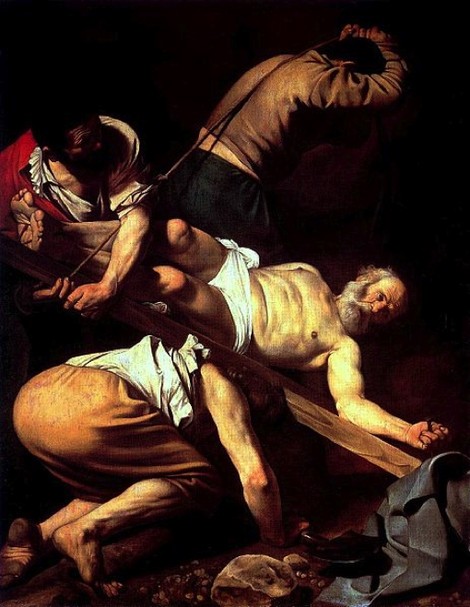
Michelangelo Merisi da Caravaggio, The Crucifixion of Saint Peter, 1601. Cerasi Chapel, Santa Maria del Popolo, Rome. | Photo: Courtesy of Wikipedia Commons.
One of most entertaining and overt examples of a contemporary artist engaging with his Christian faith in Los Angeles from nearly a decade ago was Reverend Ethan Acres. He hailed from Alabama and graduated from the University of Las Vegas in 1996. He was and is an ordained minister and had no qualms about fighting the Devil and sins via his art. Eventually, he left Los Angeles for other parts of the country to proselytize rather than speak-in-tongues with his sculptures and performances. You can see some of His Church of the Holy Fool antics on YouTube.
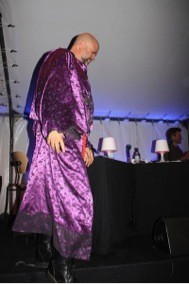
Reverend Ethan Acres Performing. | Photo: Shape Two/Flickr/Creative Commons License
However, Acres is the rare artist who found acceptance in galleries and museums. In reality, the underlying faith of most contemporary artists who subscribe to Christianity is not apparent in their work, unlike the past when an artist was in service to the Catholic Church as a dominant patron. So, does it matter, either to another Christian, or to a secular contemporary art world, whether their religious convictions are apparent or not in their work? The reader will need to answer this question.
So, with these thoughts, this article's attention turns to the performance and video artist, Kent Anderson Butler, who is based in Pomona. The following interview was conducted for the catalog that accompanied his ten-year survey about a year ago. He is an artist who is open about his Christianity, and like Reverend Ethan Acres, has found a unique path that allows him to keep-the-faith towards both his religious convictions and towards the contemporary art world's secular persuasions. With respect to his boldness, in light of possible rejection from the contemporary art world, the interview was titled, "An Un-embarrassing Embrace: A Conversation with Kent Anderson Butler."
Crossing Paths
I have had the opportunity to follow Kent Anderson Butler's exhibition career for many years. The iconic quality of his videos has stuck with me. This is due in part to Butler's development of a unique vocabulary. A majority of the videos include himself, are in slow motion, and focus on a single gesture that takes place in a private space, whether interior or exterior, sometimes a bathroom, and other times a park, for example. The underlying motivation is less about self-exploration and more about an attempt at deep communication, using both "the body" and the "the spirit" as avenues for connecting with fellow humans and with something larger than humanity. In essence, Butler's video works from 2002 to 2012 embody a profound commitment to art and its intentionally ambiguous delivery as a valid path for insightful discoveries about the human condition.
Butler graduated from California State University Fullerton in 1998 with a Masters in Fine Arts. As a graduate student, he made live performance work predominantly, and then slowly moved into video. Performance is still very much part of this work, but more secondary at this point. Butler's mature phase in his production begins with his video works from 2002 and onward. They are at the heart of the conversation that follows.
INFLUENCES
Tyler Stallings: What were some of the artists you were looking at while you were at grad school in the late 1990s?
Kent Anderson Butler: I was looking a lot at Renaissance and Baroque painting and the dialogue between the mediums of painting and photography is what influenced me. I would go to the Getty or LACMA and spend time looking at historical paintings. I also became really interested in the work of Bill Viola. His work and life have had a big influence all throughout my career.
TS: Yeah, it seems that both you and Viola are influenced by paintings. You both share the use of an extreme slow motion technique that creates for the viewer that static quality of a painting. A viewer has to pay a lot of attention in order to have a deeper relationship. I would say that one of the big differences is that you are the center of all your videos. Viola is mainly the director of his videos, at least nowadays.
KAB: A lot of my technique of slowing things down comes from my childhood and being a latchkey kid. I grew up in the Sacramento area. When I was a child, it was very common to come home after school on any given day and while my parents were at work I'd watch TV. It was a time when MTV came on the scene, in the early 1980s. I am a child of that culture, but on the other hand, working in the medium of video or a moving image, I am making a very conscious decision about the time that is allotted in the pieces. I am really interested in challenging the viewer's idea or aesthetic of what they expect from a moving image.
TS: Perhaps watching MTV was your first introduction to a more artful way of looking at what you could creatively do with the technology, as opposed to thinking in terms of video being either dramatic TV or documentaries. The irony is that of course MTV music videos, you know, they have gotten known for that quick editing. In a way that quick editing is due not only to the timing of the narrative within the piece of music but it's also an acknowledgement by the makers that people are quick learners. You don't have to spend so much time on a moment because just a fragment of something is enough for people to understand the reference. But in your work, even to this day, in spite of accelerated, rapid editing, your pieces are getting longer.
PROCESS
TS: I've noticed in your videos that they are either two and a half or five minutes long. I don't know if that's just an intuitive thing or through your own editing process and post production that it seems to be the right amount of time in order to speak to a gesture that you want to emphasize.
KAB: Before 2002, I did a couple of pieces around the 25 minute range but they were also pieces designed where the viewer didn't necessarily have to be there the whole entire time. I tend to consciously think about the viewer's time and the average viewer wanting to engage in a moving image and what that kind of attention span that may be. It is in the back of my mind. Now, I tend to want the viewer to stay there from beginning to end.
TS: What's an example of something that has inspired a video?
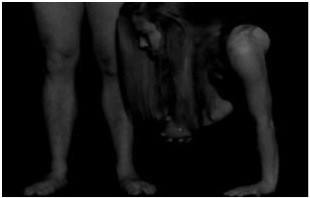
Kent Anderson Butler, Lament, 2004. | Photo: Courtesy of the Artist.
KAB: Sometimes it starts with reading something or seeing something that really strikes me. For example, in Lament from 2004, that whole piece began to manifest itself while I was reading a story in the Bible. It was a passage in the gospels where Mary Magdalene wipes Christ's feet with a jar of her own perfume and uses her hair as a wiping mechanism. I wasn't really interested in the narrative when I first read it, and part of that is because growing up in the church and hearing those narratives, sometimes it gets easy to grow numb to them. But I was really struck by such an incredible image. What's interesting to me is that it really opened up my eyes to the narrative itself.
TS: Using this as an example, tell me more about your decision making process. In Lament, you shoot just below your knees, the woman crawling from off frame, then going back out, having a black backdrop....
KAB: During that time I had done a couple of different pieces that used a type of chiaroscuro lighting, very dramatic, up against this black void because I was taken by those Renaissance and Baroque paintings, especially Rembrandt. I thought that I don't want to re-portray the narrative, and I wasn't really interested in the verbal conversation between the two people. I was trying to figure out the best way to focus on the image and what it communicated. A lot of times I will do little sketches where I work things out visually, almost like a storyboard in terms of perspective and angle.
TS: That was my next question. Do you create a specific storyboard or get a rough idea and then improvise it?
KAB: Everything is pretty set up. Sometimes, I do a little storyboard, and other times I have it in my head but I know exactly what I want to see visually in that rectangular frame. One of the most difficult things is finding the right people to be a part of the work. Especially when it's not just me.
TS: What would be your shooting ratio in terms of how much you shoot versus that final edited, say two and a half, five minutes.
KAB: Usually what happens, on a lot of the pieces, especially before the new Embodied series, oftentimes I'll do several takes, so it could be anywhere between five and twenty takes in one day. Depending on the piece, it gets really physical and grueling, but at the same time, it usually ends up that the last takes tend to be the best. Within the majority of my work, everything is happening in one take, for the most part.
WOMEN
TS: One thing I noticed, after seeing Lament, Exclusion, Immersion, and a few other earlier pieces, is that it seems up until Offering in 2008, the other person in the piece has mostly been a woman, with one or two exceptions. In Offering, you suddenly see men for the first time with the mopping and lifting you up. Then there was a man in the Embodied series but primarily it's always been one or two women.
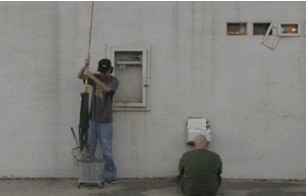
Kent Anderson Butler, Offering, 2008. | Photo: Courtesy of the Artist.
KAB: Yeah, I think about gender a lot. In Lament, for example, I was thinking that here's this woman, serving this man, in an embarrassing way....
TS: ...subservient....
KAB: Yeah, subservient. So I think that there are times when gender roles pop up in the work from time to time.
TS: If I saw "Lament" by itself those sorts of issues about subservience would come up but I wouldn't say it comes up at all in any of your other works, necessarily, with the women. In "Exclusion," or "Immersion," you had a woman shaking you, and the woman in the water pulls you down. She is a very active person. I almost feel "Lament" is an anomaly in terms of the overtness of the apparent subservience. In your body of work, I wouldn't use that word for the piece in retrospect, but to me it's about two people trying to communicate with one another, in whatever form that may be and sometimes in the face of apparent impossibility of communication, even though you're touching. You have the angry woman, you have the one pulling you down, you have, "Lament", you know brushing the oil on the feet, well then even with men. In "Passage" you have a lot of hugging and touching, embracing and sometimes as an in the "Embodied" series or "Lustration," there can be times when there is camaraderie between two women with the exclusion of you being there, they are almost conspiring. They are obviously in their own world because they've hugged, greeted each other, doing an activity together, and they are doing it to you in the end, but then they walk off still in their own world.
KAB: Some of it stems from throughout my life I have always had an extremely difficult time in terms of having solid relationships with women. In high school, junior high, I was always the kid who, you know, would find a gal I was interested in but nothing ever panned out. I always got the shaft. I think that for later years, through college and beyond, there was definitely a void, a longing there. I think the first piece I ever did with another person beside myself was in 2001 and that was called "The Embrace In Which I Long For." It's this video of a gal and me and we are embracing one another for like twenty-five minutes. I think there is a layer spread throughout the work where there is this need and longing I had in my life for a long time. In some ways I feel like certain individuals have trampled on me. Whether that be true or not, that's a whole other thing. I think at the same time I have a huge respect for women and I think that things really started to change in terms of who was going to be in my work when I got married to my wife, Heidi.
TS: Is your wife in any of the videos?
KAB: She is in "Offering." She is the woman who comes in and takes the shirt off my body while I'm hanging upside down and kisses me. That's the only piece she has been in.
TS: Ironically, I find that one of the most different pieces. It felt as if you were creating a tableau, unlike the other ones that feel more like portraiture. You're sitting horizontal, you have the guy mopping, then another guy comes and picks you up, and the woman comes and takes your shirt off and then the two men take you away. Compared to what led up to this work, it was a pretty choreographed situation where there was a lot of movement between characters for the viewer to watch.
SPIRIT
TS: I'd like to discuss where you went to school, Biola University, and where you now teach, Azusa Pacific University. It seems that being at evangelical Christian universities has been a big part of your life. Most artists don't talk about religious affiliation in contemporary art for the most part. At the most they talk about spirituality but there is rarely a specific denomination or faith mentioned. To say that you're part of the contemporary art world tends to suggest that you are engage in questioning institutions, power, and ideology, which could be view as anathema to expressing an open allegiance to a faith, especially one that has been so institutionalized.
KAB: There's a lot there. I am a devout Christian. I am an evangelical.
TS: How would you define evangelical for yourself? I personally consider evangelical involving proselytizing and being out there as opposed to just doing your own thing without proselytizing, but that's my simple viewpoint.
KAB: I don't think I look at it that way. Being an evangelical, I look at it more as my belief is that I am a vessel, a body that God is using to touch the lives of people, touch the lives of others.
TS: To add to what you're saying, in one of your early statements for your 2003 show at San Bernardino, you quoted the early twentieth century French philosopher and Jesuit priest, Pierre Teilhard de Chardin. He was trying to present a twist, saying that perhaps we are spiritual beings having a human experience, as opposed to human beings having spiritual experience. His twist is that the flesh, the body is temporary, but the spirit always exists, though maybe just in a different vessel.
KAB: Yes and I think that's one way how I process things and look at things in my life. I grew up in Christian environment as well. I had always gone to public school my whole life. My parents have always been extremely encouraging in terms of creativity and whatever I decide to do in life. I didn't come from a very strict upbringing. I have some friends who couldn't listen to certain types of music, for example, but I had a very wonderful childhood. When it came time for me to decide to go to college, I had just gotten back into art. I was planning on going to culinary school but then I re-found my love of making art while taking a couple classes in high school. So at the time I was extremely active in church youth group. I grew up in a Baptist church. I chose to go specifically to a Christian university. The main reason for that was that I really wanted to try and understand what does it mean to take this worldview that I have, that I hold to, and that I am passionate about, and integrate it into my lifelong practice as an artist.
LOCATION
TS: In terms of the settings for your work, it is either in a domestic setting, clearly an interior space, or an exterior, public setting. Sometimes you are in a park where you are laying in the grass, the playground when you're on the swing, you're behind the building where the mopping is, you're walking on a roadway, you're in a public bathroom on a toilet. In the domestic situation, you're in the bathroom, or the bathtub full of the milk-type substance, overall, you are in environments clearly constructed by man. You are a dweller in this sort of man made world whether it's inside or outside. As opposed to going on a mountaintop that's clearly not man-made, you go to a park that is completely man-made.

Kent Anderson Butler, Submergence, 2008. | Photo: Courtesy of the Artist.
KAB: Environment and location are extremely important to the work. For example in the Embodied series, part of the reason for going out to the Salton Sea and going to places like Bombay Beach where this community has been uprooted is because I am interested in that dialogue between the landscape and what's happened to it in terms of man's habitation, then leaving it, and also the history of the sea and how it was created. But then also, locations like a bathroom, which is used in the pieces, Lustration, Sacred Throne, and Submergence, I often think about the idea of what constitutes a sacred space.
TS: Yeah I think that comes through in the Sacred Throne piece because your singing the song of--I didn't quite catch the words but my sense was that it was a song of praise or adulation, but basically the idea seemed to be that in any location you can find relief, whether physical relief like having a bowel movement or pissing, but despite that lowly bodily activity, you can still have revelation. Reinforced by the stall being this kind of private space of contemplation. Literally a monkish cell or confessional booth.
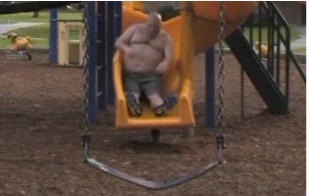
Kent Anderson Butler, Hallowed Pondering, 2008. | Photo: Courtesy of the Artist.
KAB: I'm very interested too in the attention that gets played out between a particular location and the activity that is happening. For example like with, "Hallowed Pondering," where you have me, this man, with his shirt off on this playground swing. That's a very odd environment for a grown man to be doing this activity in this location. But I think about what those things could mean, how they could be perceived.
TS: When you look at all the work together there is this overriding idea of finding a spiritual place of contemplation or a place of communication between people in a daily world. But there is a disturbing quality because you are the center of all those activities. There is this voyeuristic quality for the viewer that seems almost at odds.
KAB: Right.
VULNERABILITY
TS: There's discomfort and sympathy with the "character" in your videos, which is you, and who through all these countless tapes is flagellating, or doing something to his body in order to achieve something higher. He is setting up these situations for people to do these things to him. In a way it's understandable, there's a history of that, but then for this character to feel the need to be an exhibitionist about it to me is one of the key things that creates this interesting tension for the viewer, a discomfort.
KAB: I think that part of it is that I do enjoy allowing the work to create uneasiness or tension. I find it extremely humorous in some cases, but when I do that I'm also trying to allow the viewer to feel something that I'm feeling.
TS: One way you do that really well is through use of sound.
KAB: Sound or the lack of sound is very important in a lot of my work.
TS: Whether it's slowing it down with the film, or hearing heavy breathing or stress involved.
KAB: I remember thinking about some of Chris Burden's early pieces. I thought it would have been really fascinating to be there during certain ones. I've always felt that when I see some of that early work, he was trying to allow the viewer to experience what he was experiencing so I've always thought about that and how do I create something where I am able to take things I'm convicted about and I'm questioning and working out in my own life and transcribe them into a piece of art that others can take away for themselves and use and somehow think about and benefit from and experience. With the work there's a lot of stuff that happens that is rooted in a lot of things that happened in my childhood as well.
I don't know if I shared this story with you, but I was born "preemie," two months early. Because of that I had several medical problems. By the time I was sixteen, I went through about twenty different surgeries. I have really distinct memories of some of them. A lot aren't good ones. Especially ones of going to the hospital, and others of going under anesthesia. Of course the outcomes have been wonderful. I have always had this love/hate relationship with medicine and with doctors and such but because there was so much wrong with my body, it really plays into the work. Also, always growing up being heavy, or overweight definitely has been difficult so I think dealing with body image and those sorts of things is an issue. One way I have been able to get passed that is to learn how to be content with my body.
TS: I would say that those struggles definitely come through in the video. When I look at the videos, I don't think, "Oh, heavy person." I just think, "Interesting body." For example, the artist Martin Kersels is tall and very heavy, and he does the opposite in his work. He acknowledges himself as an awkward character. Tripping, putting others in danger through falling on them. He is taking a very humorous approach, whereas I don't feel that is your approach at all.
KAB: It's always been sort of an issue. Going back to this idea that I still feel this body is temporal. Once I pass on from this place, my soul goes on to live. It's kind of this interesting dichotomy that gets played out.
EXCHANGE
TS: In "Holy Kiss" from 2005, it seemed to be the first time where you looked at the camera. Up to that point, you were pretty stoical, and just let stuff happen to you. Because of not looking at the camera, you really stayed in your private world, as the character.
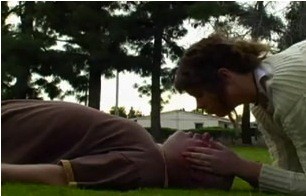
Kent Anderson Butler, 'Holy Kiss,' 2005. | Photo: Courtesy of the Artist.
KAB: In the pieces where you don't see that, especially before "Holy Kiss," it makes me think a lot about this idea--"the eyes are the window to the soul"--and so I think that sometimes I feel like when I am looking at the camera, at the viewer, that maybe I am allowing the viewer to see a little bit more of me internally than in some of the pieces where I'm not. I do feel that when I do that I am being more vulnerable to the viewer in some cases. At the same time it could be kind of confrontational too.
TS: It doesn't feel confrontational.
KAB: I don't want it to be heavy handed.
TS: I'd say it's more about vulnerability, letting people in. Through acknowledging their presence, the person watching has to decide how they are going to act. You aren't accusing them, it isn't confrontational, it's more like well, this is what I'm doing, now what are you going to do.
One of the other broad themes in your work is what I would call communication or an attempt at it. One of my favorites that seem to be directly about that is "Passage." I like that it's from this bird's eye view of the car lanes. You have these two people who traverse the lanes, they are ignoring the law. One because they are pedestrians, in terms of the literalness of it, and also because they are ignoring what the lanes are supposed to signify. By crossing the lanes perpendicular to the verticality, they ignore the "law of the land" in order to arrive at their own objective which is to hug one another. It's this idea of human contact in a situation where we don't think of human contact.
What about, in terms of use of sound, when you are putting your body in the way of distressing situations, there is an emphasis on the breath, sometimes subtle, ambient, but you either heighten it, or whatever, but it seems that it's a sign of the literalness of the difficult stressful physical situation.
KAB: Breathing is an activity that we take for granted. It's what sustains us; it allows us to be there. There is a certain intimacy and vulnerability when you're close enough where you can hear that sound. It's a different sound for different individuals. I find it fascinating that it is this activity that takes place when you are born into the world and you breathe your first breath of life and when you exit the world, the activity no longer exists.
TS: It made me think of (Marina) Abramovi? and Ulay's (Uwe Laysiepen) piece, "Breathing in, Breathing out" (1976), where they created the mechanism in which they exchange one another's breath to the point of no new oxygen being created, to the point of their both passing out. In essence they are exchanging one another's life giving breath, but the result could be death.??Talk a little bit more about why you have the desire to expose your body in so much of your work.
I thought one of the interesting ones was the "Ascension" piece because you're wearing underwear as opposed to swim trunks. It's like this idea of emerging as a fully formed adult from the womb of the pool, the water, and the vessel. It has a semi-diaper suggestion, maybe baby thing.
EMBRACE
TS: Are you going to produce any new work for the show?
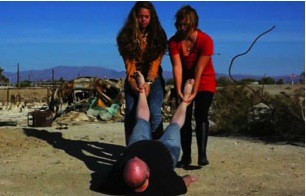
Kent Anderson Butler, Embodied Fusion, 2010-11. | Photo: Courtesy of the Artist.
KAB: There will be one new video piece. I am bringing in elements of man and landscape. I am extremely excited about it but also nervous because I do not know what it's going to communicate. It's very simple. It's going to be shot in the forest. I don't know if the orientation is going to be horizontal or vertical, but in the background, in the forest, there is a man ironing work shirts. That's how it opens, that's all you see. I am going to have my shirt off and I will run up a path and it will be all slowed down. I am going to run up to the camera and just stand there. I will actually speak to the viewer, which is kind of a little different from my past work. I'll whisper, "I love you, will you love me?" and just turn around and run back, and the guy is still ironing. That's like the whole piece, you know. That phrase started the piece. I don't even know where it came from. It got me to really think, "Well, what does that phrase mean?

Kent Anderson Butler Videos. | Photo: Courtesy of the artist.
To view more of Kent Anderson Butler's work, visit his website.
December 12, 2012
TYLER STALLINGS

Tyler Stallings is the artistic director at Culver Center of the Arts and director of Sweeney Art Gallery at University of California, Riverside. He was chief curator at Laguna Art Museum from 1999 to 2006. His curatorial projects focus on contemporary art, with a special emphasis on the exploration of identity, technology, photography, and urban culture. In the past, he has organized Whiteness, A Wayward Construction, Surf Culture—The Art History of Surfing, Re:Cycle—Bike Culture in Southern California; Mapping the Desert/Deserting the Map: An Interdisciplinary Response, and Truthiness: Photography as Sculpture. He is currently working on the exhibition Free Enterprise: the Art of Citizen Space Exploration. Most recently, he was part of the curatorial research team and essayist for Backyard Oasis: The Swimming Pool in Southern California Photography, 1945-1980, organized by Palm Springs Art Museum as part of the multi-institutional Getty Research Institute initiative, Pacific Standard Time: Art in L.A., 1945-1980. He is also the co-editor of the anthology, Uncontrollable Bodies: Testimonies of Identity and Culture (Seattle: Bay Press, 1994).
Websites: http://tylerstallings.com, http://culvercenter.ucr.edu, http://sweeney.ucr.edu
Originally published on: http://www.kcet.org/arts/artbo...
Used by permisssion from the author.